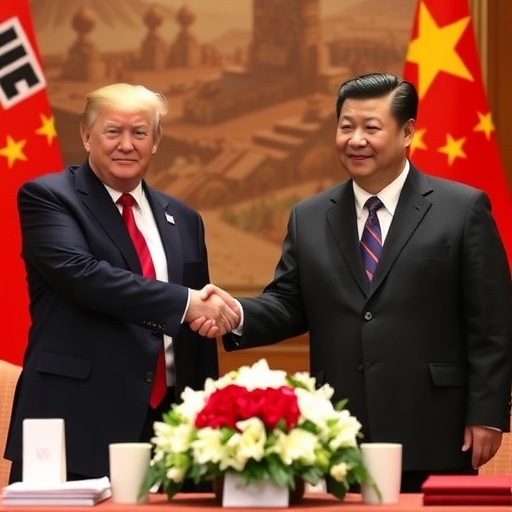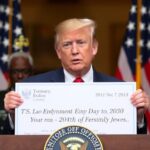Trump and Xi Jinping to Hold Pivotal Summit in South Korea, Eyeing Game-Changing Trade Deal
In a move that could reshape global trade dynamics, President Donald Trump and Chinese President Xi Jinping are set to convene in South Korea for a high-stakes economic summit. The leaders will meet on the sidelines of the Asia-Pacific Economic Cooperation (APEC) forum in Seoul next month, aiming to hammer out the final details of a landmark trade deal. This unexpected venue shift from traditional U.S.-China bilateral talks underscores the urgency and diplomatic maneuvering at play, as both nations seek to thaw a trade war that has cost billions and rattled markets worldwide.
- Breakthrough Negotiations Signal End to Trade War Tensions
- South Korea Emerges as Strategic Host for U.S.-China Trade Deal Talks
- Unpacking the Core Elements of the Anticipated Trade Deal
- Global Markets Brace for Ripple Effects from Seoul Summit
- Looking Ahead: Potential Outcomes and Lasting Impacts of the Trade Summit
The announcement, confirmed by White House officials on Wednesday, comes amid reports of accelerated negotiations following a series of virtual huddles between U.S. and Chinese trade representatives. Sources close to the talks reveal that progress on reducing tariffs and opening markets has been substantial, with both sides expressing optimism for a breakthrough. “This summit represents a critical juncture in U.S.-China relations,” said a senior administration official, speaking anonymously. “President Trump is committed to securing a fair deal that benefits American workers and farmers.”
The choice of South Korea as the backdrop adds intrigue, positioning the summit within a broader regional economic conference. Seoul’s neutral stance and its own vested interests in stable U.S.-China ties make it an ideal host, analysts say. With global supply chains still reeling from pandemic disruptions and geopolitical tensions, the eyes of the world will be on this encounter between the leaders of the two largest economies.
Breakthrough Negotiations Signal End to Trade War Tensions
Recent breakthroughs in U.S.-China trade talks have set the stage for the upcoming summit in South Korea, where Trump and Xi Jinping hope to seal a comprehensive trade deal. Over the past six months, negotiators have made significant headway on contentious issues that have defined the bilateral relationship since 2018. According to data from the U.S. Trade Representative’s office, bilateral trade volumes dipped by 18% during the height of tariffs in 2019, but preliminary agreements have already led to a 12% rebound in exports of U.S. agricultural goods to China this year.
Key concessions from Beijing include commitments to purchase an additional $200 billion in American energy and manufactured products over the next two years, up from the $77 billion outlined in the Phase One deal of 2020. In return, the U.S. has signaled willingness to ease restrictions on certain technology transfers, though core national security concerns remain non-negotiable. “We’ve seen real movement on intellectual property protections, which is a win for American innovators,” noted economist Dr. Elena Ramirez from the Brookings Institution. “This progress isn’t just numbers on a page; it’s about restoring confidence in global markets.”
Trump, known for his aggressive tariff policies, has touted the negotiations as a personal triumph. In a recent tweet, he wrote, “Great progress with China on trade – deals like this put America first! Heading to South Korea to make it official with President Xi.” Xi, meanwhile, has emphasized mutual respect in state media, stating that the talks embody “win-win cooperation.” These developments follow a series of high-level phone calls and envoy meetings, including a pivotal October session in Geneva that reportedly narrowed differences on currency manipulation allegations.
Yet, challenges persist. Labor unions in the U.S. have voiced concerns over potential job offshoring, while Chinese state-owned enterprises worry about increased scrutiny on subsidies. Statistics from the World Bank indicate that the ongoing trade frictions have slowed global GDP growth by 0.5% annually since 2018, amplifying the pressure on both leaders to deliver at the South Korea summit.
South Korea Emerges as Strategic Host for U.S.-China Trade Deal Talks
South Korea’s selection as the venue for the Trump-Xi summit highlights its growing role as a diplomatic hub in Asia, bridging the divide between Washington and Beijing. The meeting will occur alongside the APEC summit in Seoul from November 15-18, allowing the leaders to leverage the multilateral platform while conducting bilateral discussions in private. This setup not only saves on logistics but also symbolizes Seoul’s commitment to regional stability amid U.S.-China rivalry.
President Yoon Suk-yeol’s administration has been instrumental in facilitating these talks, offering neutral ground that neither superpower could easily refuse. South Korea, with its export-driven economy heavily reliant on both U.S. and Chinese markets, stands to gain immensely from a resolved trade deal. In 2022, trade with China accounted for 25% of South Korea’s total exports, while the U.S. represents a key ally in security matters. “Hosting this summit is a testament to our balanced diplomacy,” Yoon said during a press briefing. “We hope it leads to prosperity for all in the Asia-Pacific.”
Historically, South Korea has mediated similar high-profile encounters. The 2018 inter-Korean summit in Panmunjom paved the way for U.S.-North Korea talks, demonstrating Seoul’s prowess in quiet diplomacy. For the upcoming event, security measures are already ramping up, with thousands of police deployed and airspace restrictions imposed around key venues. Local businesses in Seoul are buzzing with anticipation, expecting a tourism boost similar to the $1.2 billion economic windfall from the 2010 G20 summit.
Geopolitically, the location adds layers of complexity. North Korea’s nuclear ambitions and Taiwan Strait tensions loom large, potentially influencing the trade agenda. Experts predict that side discussions could touch on these issues, with South Korea advocating for de-escalation. As one diplomat put it, “Seoul isn’t just a backdrop; it’s a catalyst for broader dialogue.”
Unpacking the Core Elements of the Anticipated Trade Deal
At the heart of the Trump-Xi summit in South Korea lies a multifaceted trade deal designed to address long-standing grievances while fostering new opportunities. Central to the agreement are tariff reductions: the U.S. plans to slash duties on $300 billion worth of Chinese imports, including electronics and apparel, in exchange for Beijing dismantling non-tariff barriers on U.S. autos and pharmaceuticals. This reciprocity is projected to add $150 billion to annual bilateral trade, per estimates from the Peterson Institute for International Economics.
Technology and intellectual property (IP) protections form another pillar. China has agreed to strengthen enforcement against IP theft, a sore point for U.S. firms like Apple and Qualcomm, which reported $50 billion in annual losses due to counterfeiting. The deal includes provisions for joint U.S.-China task forces to monitor compliance, with penalties for violations. “This is a step toward leveling the playing field,” said U.S. Commerce Secretary Gina Raimondo in a recent interview. “Innovation thrives when rules are fair.”
Agriculture and energy sectors will see immediate benefits. China’s pledge to import $50 billion more in U.S. soybeans, pork, and liquefied natural gas addresses farmer hardships exacerbated by prior tariffs. Meanwhile, environmental commitments, such as joint initiatives on clean energy tech, align with global sustainability goals. The deal also tackles currency issues, with mechanisms to prevent manipulation that could undermine competitive edges.
- Tariff Cuts: Phased reduction on 70% of covered goods over three years.
- Market Access: China to open financial services to U.S. banks; U.S. to ease export controls on non-sensitive tech.
- Enforcement: Independent dispute resolution panel with binding arbitration.
Critics, however, warn of enforcement gaps. A report by the Center for Strategic and International Studies highlights that previous deals saw only 60% compliance, urging robust monitoring at the South Korea summit.
Global Markets Brace for Ripple Effects from Seoul Summit
Financial markets are already pricing in optimism for the Trump-Xi trade deal, with stock indices in New York, Shanghai, and Seoul showing gains in pre-summit trading. The Dow Jones Industrial Average surged 2.5% last week on rumors of the meeting, while the Shanghai Composite climbed 1.8%. Analysts attribute this to expectations of reduced uncertainty, which has plagued investor sentiment since the trade war’s onset.
Sector-specific impacts are pronounced. U.S. tech stocks like Boeing and Caterpillar, hit hard by export curbs, could see valuations rise by 15-20% post-deal, according to Goldman Sachs projections. In China, consumer goods firms stand to benefit from cheaper imports, potentially boosting retail sales by 5%. South Korea’s semiconductor industry, a linchpin in global supply chains, anticipates smoother flows, with Samsung Electronics forecasting a 10% revenue uptick.
Broader implications extend to emerging markets. Countries like Vietnam and Mexico, which absorbed diverted trade during the war, may face redirected investments. The International Monetary Fund (IMF) estimates that a full U.S.-China resolution could accelerate global growth by 0.8% in 2024, averting a projected slowdown. “The summit could be the spark that reignites trade optimism,” said IMF Chief Economist Pierre-Olivier Gourinchas.
However, volatility risks remain. If talks falter, markets could plunge, echoing the 10% drop in 2018. Currency traders are watching the yuan-dollar pair closely, with hedges against depreciation surging. In South Korea, the won has strengthened 3% against the dollar, reflecting local enthusiasm.
Looking Ahead: Potential Outcomes and Lasting Impacts of the Trade Summit
As Trump and Xi Jinping prepare for their South Korea summit, the world anticipates outcomes that could redefine economic alliances for decades. A successful trade deal would not only stabilize U.S.-China relations but also set precedents for multilateral trade pacts, potentially revitalizing the World Trade Organization’s role in dispute resolution. Experts foresee enhanced cooperation on non-trade fronts, such as climate change and pandemic preparedness, building on the summit’s momentum.
For American workers, the agreement promises job creation in export-heavy states like Iowa and Texas, where agriculture employs millions. In China, it could spur domestic reforms, encouraging a shift from state-led growth to market-driven innovation. South Korea, as host, positions itself as a key player in future diplomacy, possibly mediating other regional flashpoints.
Challenges ahead include domestic ratification in the U.S. Congress and adherence amid election cycles. Yet, with both leaders invested, the summit holds promise for a more interconnected global economy. As negotiations intensify, all signs point to a historic pivot—one that could usher in an era of prosperity or, if unmet, deepen divisions. Stakeholders from Wall Street to Main Street will be glued to developments from Seoul, eager for the next chapter in this high-stakes saga.








